Imaging almost nothing at all
PUNCH, the Polarimeter to UNify the Corona and Heliosphere, is a NASA Small Explorer mission. It’s the latest in a long line of space instruments and missions built by Southwest Research Institute (SwRI) to study the Sun and the solar wind. The four suitcase-sized spacecraft were built in SwRI’s new Space Systems Integration Facility and launched together into Sun-synchronous low Earth orbit over the dawn/dusk line. The four satellites are synched to work as a single “virtual” instrument 8,000 miles across to collect wide-field, 3D movies of the entire inner solar system.
The SwRI-led PUNCH mission will integrate our understanding of the Sun’s corona — the outer atmosphere visible during total solar eclipses — and the “solar wind” that fills and defines the solar system. With it, we’ll be able to routinely see and understand the solar wind itself, as it streams out from our star and washes over the Earth.
PUNCH is an imaging mission, but it does not use a telescope. Its four ordinary cameras together have a broad field of view 90 degrees across, focused on the medium that surrounds and washes over us. Launched on March 11, PUNCH has a 90-day commissioning interval. Then, starting in June 2025, the four spacecraft will work together to image the solar wind as it accelerates through the Sun’s outer corona and streaks toward our home planet.
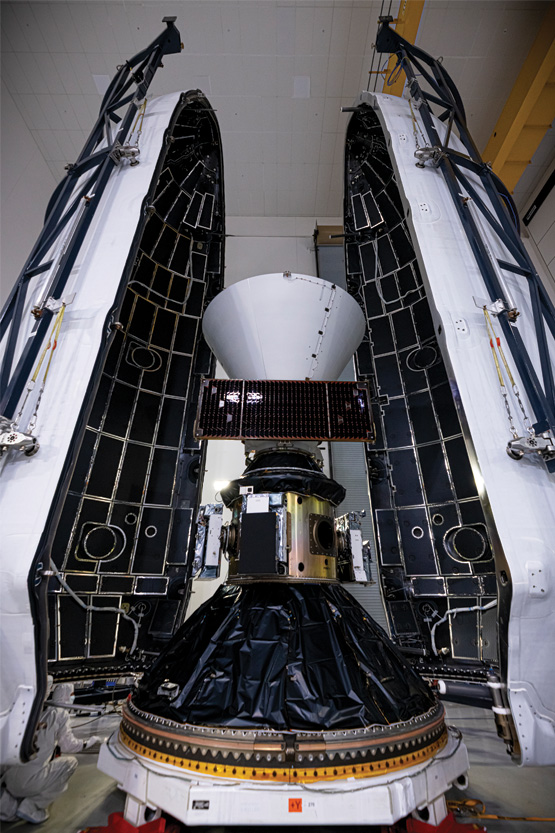
Prior to launch, the PUNCH spacecraft were attached to the gold colored ESPA ring designed to deploy secondary payloads, below NASA’s SPHEREx observatory, to cost-effectively share a ride to space. PUNCH’s four small suitcase-sized spacecraft, designed and built by Southwest Research Institute, will revolutionize our understanding of how the solar corona, the Sun’s outer atmosphere, becomes the solar wind that fills and defines our heliosphere.
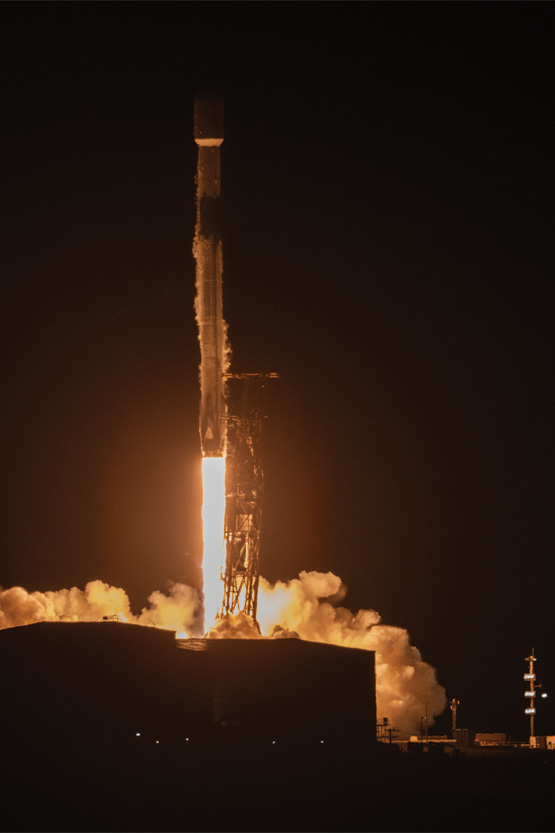
A SpaceX Falcon 9 rocket, carrying NASA’s SPHEREx (Spectro-Photometer for the History of the Universe, Epoch of Reionization and Ices Explorer) observatory and the PUNCH satellites, launched from Space Launch Complex 4 East at Vandenberg Space Force Base in California on Tuesday, March 11, 2025.
Merging Solar with Heliospheric Science
Until recently, solar physics and heliospheric physics were divided by technology. Solar physics, which studies the Sun itself, mainly uses remote sensing technology, such as telescopes or spectrometers, to view our star and its corona on scales from a few hundred miles to a million miles. Heliospheric physics, which studies the protective bubble around the solar system and the solar wind itself, mainly uses direct, in-situ sampling. As the solar wind sweeps over a spacecraft, the probe collects samples that reveal the composition, temperature, speed, magnetic field and even magnetic connectivity of individual parcels of the tenuous material on scales as small as 100 yards.

With PUNCH, those two fields are merging. Three times per year, NASA’s Parker Solar Probe carries its instruments through the outer solar corona to use in-situ techniques on the Sun itself. PUNCH works in the other direction, bringing coronal imaging outward to apply solar physics techniques to the solar wind between planets.
At over 1.5 million degrees Fahrenheit, the solar corona is so hot that it is a plasma — a fluid made up of a mixture of ions and free electrons, shaped and structured by the Sun’s magnetic field. The free electrons scatter sunlight, which makes the corona spectacularly visible during a total solar eclipse. The plasma is so hot that it continuously escapes the Sun’s gravitational pull, constantly flying off into space as the solar wind and streaking across the solar system.

(Left) The SwRI-developed Wide Field Imagers have deep baffles that reject stray light to image the faint glimmer of the solar wind. (Right) The Narrow Field Imager is a coronagraph built by the Naval Research Laboratory, specifically to work together with the WFIs and image the brightest portion of the solar corona.
Four 140-pound spacecraft are spread out in polar orbit and synchronized to act as a single “virtual instrument” 8,000 miles across. Three Wide Field Imagers and one Narrow Field Imager capture the faint glimmer from particles escaping the solar corona to form the solar wind, producing a 90-degree portrait of the sky centered on the Sun.
The solar wind is so tenuous by the time it reaches Earth that, statistically speaking, none of the particles will ever collide. They do, however, trade momentum and kinetic energy, via electric and magnetic forces. That means the solar wind follows the same fluid equations as supersonic airflows here on Earth, with the addition of electromagnetic forces. It supports waves, turbulence and shocks — just like any other fluid or plasma system. PUNCH images will allow us to distinguish large-scale fluid phenomena that are hard to analyze with in-situ sampling, even as other SwRI missions, like the Magnetospheric Multiscale (MMS) mission., analyze the microphysics of the same material near the Earth.
Planet-Sized "Virtual" Instrument

The three WFI fields of view will form a trefoil on the sky with the NFI field of view filling the center, except for a “hole” obscuring the Sun itself.
PUNCH will generate a lot of data — about one image every 17 seconds over its two-year mission. So, it needs to be close to ground-system antennas to downlink those data. Unfortunately, that also places the cameras close to a large planet — the Earth — which blocks nearly half of the view around the Sun. To see in all directions around the Sun requires building an instrument as large as the Earth. That wasn’t possible, so the team used four small spacecraft, synchronized and spread around the Earth, to create a virtual instrument 8,000 miles wide, imaging a 90-degree-wide swath of sky centered on the Sun.
One of the four PUNCH spacecraft carries a “Narrow Field Imager” (NFI), while the other three spacecraft each carry a “Wide Field Imager” (WFI). The corona varies in brightness by a factor of nearly 10,000 across the PUNCH field of view. Dividing each image between NFI and WFI reduces that to a factor of 100 across each camera’s field. Three WFIs are needed to ensure that the constellation as a whole can look outward from the Sun in all directions at all times.
Once the four spacecraft are fully deployed, the three WFI fields of view will form a trefoil on the sky and the NFI field of view will fill the center, except for a “hole” obscuring the Sun itself. Every camera intersects the field of view of every other camera, allowing the instruments to be cross calibrated. The trefoil rotates as the spacecraft orbit the Earth once every 104 minutes. They travel in a low-altitude Sun-synchronous polar orbit that keeps all four spacecraft in sunlight.
Revealing What's Hidden in Plain Sight
The features that PUNCH studies are extremely faint, with the glimmer from the solar wind less than 0.1% as bright as the Milky Way galaxy backdrop. So, PUNCH raw images contain mostly stars and “zodiacal light” — a haze caused by dust orbiting the Sun in the inner solar system. Eliminating the starfield and the zodiacal light, while preserving the very faint solar wind signal, requires extraordinary care because the smallest artifact or miscalibration would swamp the solar wind signal.
The PUNCH team has developed the most complex data processing pipeline for any NASA Explorer mission to date. The process includes precision photometric background removal and tracks the polarization of light through the entire calibration process. In addition, the PUNCH mission design merges data from four different cameras, essentially forming one “virtual instrument” with absolutely uniform imaging properties.
DETAIL
Hipparcos was a European Space Agency (ESA) satellite that mapped the positions, distances and motions of stars from 1989 to 1993.
This requires both extreme photometric precision and near-perfect co-alignment of the images. Novel resampling and correction steps compensate for optical distortion and focus effects to produce uniform data from across the constellation. The team uses a combination of precision star maps from the existing Hipparcos mission dataset and image cross-correlation to co-align PUNCH images across the entire field of view.
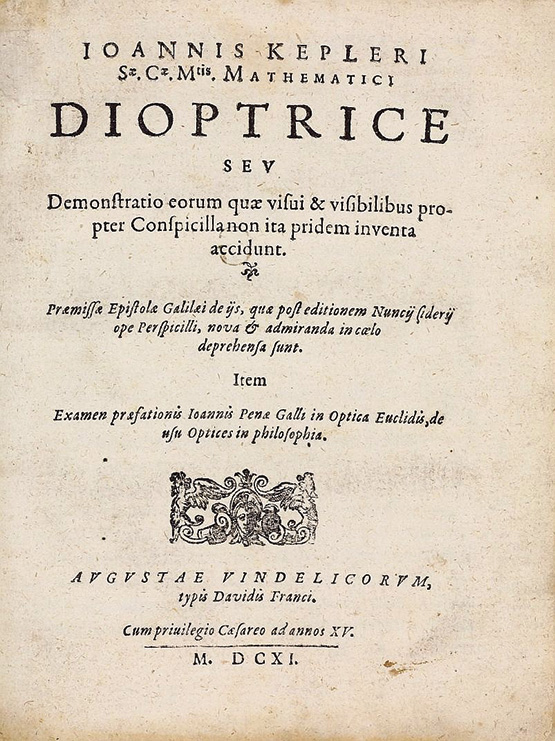
PUNCH scientists solved a 400-year-old problem in telescope design, first identified by Galileo Galilei and Johannes Kepler in 1611.
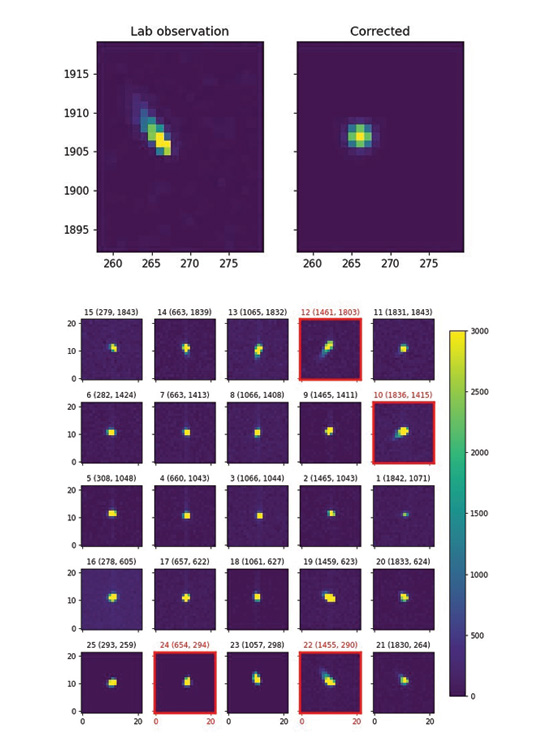
The ground team adjusts the point-spread function of each image, to produce starfields from an idealized instrument with absolutely uniform focus.
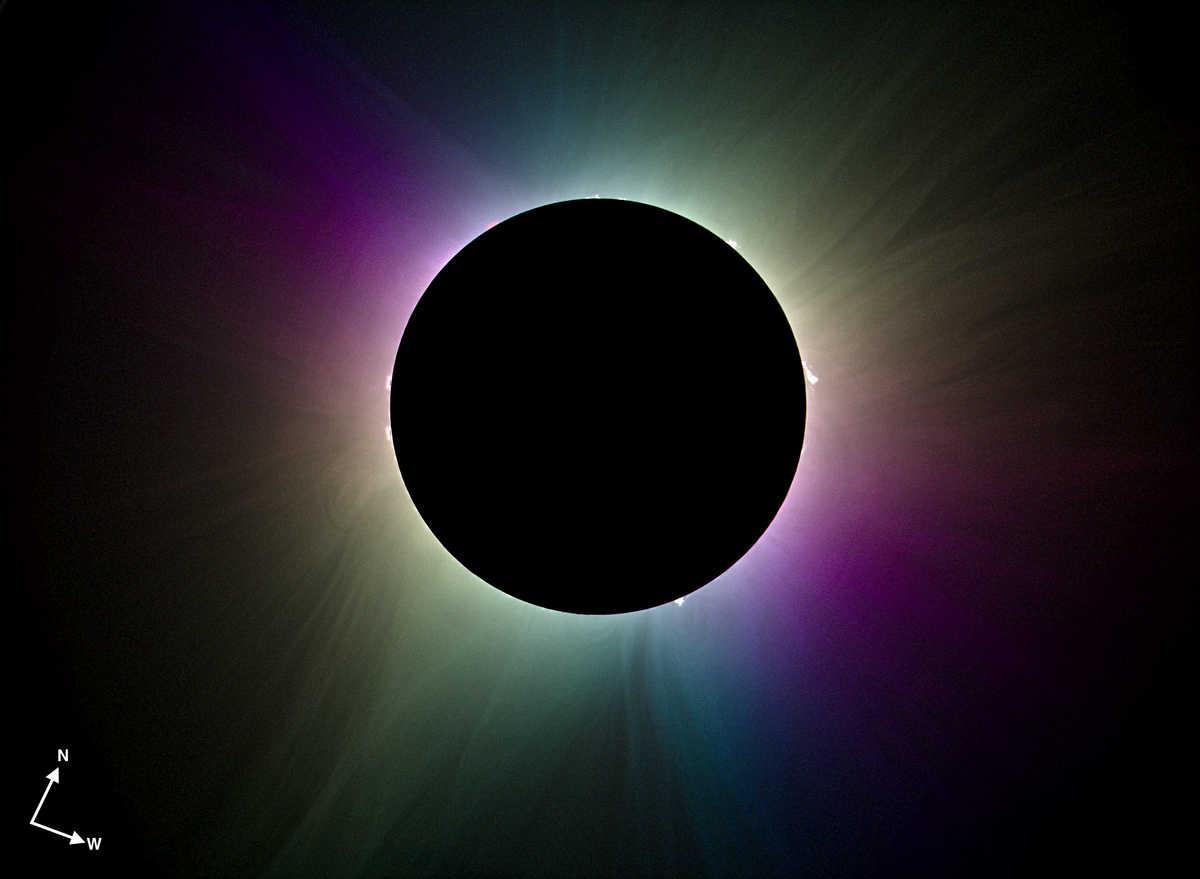
This processed image of the April 8, 2024, eclipse shows the Sun’s corona in artificial colors that indicate the degree and direction of the light’s polarization. Citizen scientists in Dallas collected these data through the SwRI-led Citizen Continental-America Telescopic Eclipse 2024 experiment.
DETAIL
Thomson scattering describes how electromagnetic radiation is scattered by charged particles, illustrated by trajectory of electrons in visible light during solar eclipse.
PUNCH uses polarization of light to measure 3D structures in the solar wind. The corona and solar wind contain free electrons, which are not attached to any particular atom. These free electrons scatter sunlight via the “Thomson scattering” process. Thomson scattering polarizes the sunlight, so that the electric field of the light oscillates or wriggles in a particular direction. The purity of the polarization encodes 3D information about the location of each feature PUNCH sees.
Measuring the linear polarization of light from the solar wind is challenging, because the solar wind is so faint compared to other sources of background light. The ground team developed a novel mathematical structure for measuring and manipulating the brightness of polarized light, applying color coordinates relevant to solar observing, while representing and removing each fixed background signal.
DETAIL
Polarization describes light waves that vibrate in a single direction. Polarized sunglasses work because many sources of glare polarize light horizontally. By admitting only vertically polarized light, the glasses eliminate glare.
SwRI Produces PUNCH
PUNCH is SwRI’s third constellation mission and the second constellation integrated completely onsite. Prior missions include NASA’s MMS mission, led by Dr. Jim Burch, senior vice president of SwRI’s Space Sector, and built at NASA’s Goddard Space Flight Center. MMS studies magnetic reconnection in Earth’s magnetosphere using in-situ sampling. SwRI’s first foray into spacecraft development was the Cyclone Global Navigation Satellite System (CYGNSS), an eight-spacecraft mission led by the University of Michigan and built at SwRI. CYGNSS assess wind speeds and hurricane intensification by studying ocean waves using reflected GPS signals.
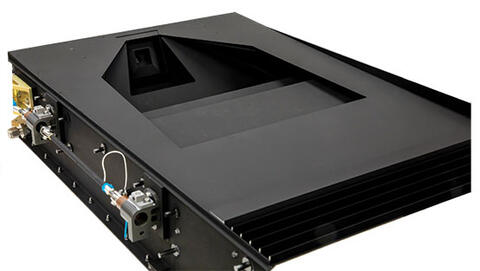
The SwRI-developed Wide Field Imagers have deep baffles that reject stray light to image the faint glimmer of the solar wind.
Like CYGNSS, the PUNCH mission aggressively leveraged commercially available subsystems and standardization to fit within the low-cost profile of NASA’s Small Explorers line. The attitude determination and control system, radio uplink/downlink, GPS navigation, propulsion, solar arrays and battery are all commercially procured and integrated with SwRI-designed structure and command and data handling systems. The primary instruments are electrically identical and use identical subsystems to further simplify the design process.
SwRI collaborated with the U.S. Naval Research Laboratory, which built the Narrow Field Imager and polarizing filter wheels for all the PUNCH instruments, and RAL Space, which built the detector systems.
PUNCH is the first mission to be fabricated entirely in SwRI’s new Space Systems Integration Facility. These expansive and vertically integrated facilities include ISO class 5, 6 and 7 clean facilities as well as multiple electrical and electromechanical laboratories, separated control rooms, an acoustic test facility, and electromagnetic compatibility and interference facilities.
PUNCH Imaging
One of the four PUNCH spacecraft carries the Narrow Field Imager (NFI), a “coronagraph” with an external occulter designed to create an artificial eclipse of the Sun’s disk. This multi-disk assembly images the far fainter corona, avoiding stray light from the Sun swamping the camera and “overexposing” the images. The NFI views in all directions around the Sun simultaneously, imaging a relatively narrow ring of light encompassing the Sun’s outer atmosphere, where the solar wind is born.
The other three PUNCH spacecraft each carry identical WFIs, “heliospheric imagers” that incorporate conventional optics and deep baffles to attenuate stray light, allowing them to image visible light scattered by free electrons in the outer corona and young solar wind. Light trap and lunar baffles are nested around the camera aperture, reducing stray light in the instrument by over 16 orders of magnitude or a factor of 10 million billion — the ratio between the mass of a human and the mass of a cold virus. The state-of-the-art processing on the ground described above removes the background starfield, over 99% of the light in each image, to reveal the extremely faint solar wind.
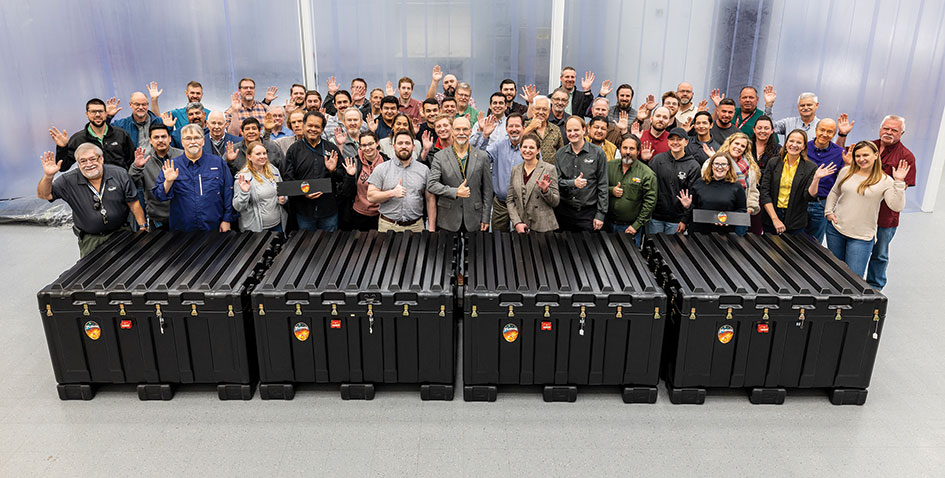
The remarkably resilient PUNCH team successfully overcame a number of late-breaking challenges over the last several months of the build to complete integration and environmental testing of the four observatories.
Operations
SwRI oversees the PUNCH Mission Operations Center (MOC) from its offices in Boulder, Colorado. The MOC has four operator positions and 12 monitoring and command stations as well as an attached conference room, secure internal data routing, voice loop equipment and trained operators to support shift operations as needed.
Data from ground passes are transferred from the MOC to the Space Operations Center (SOC) for processing and then forwarded to the Solar Data Analysis Center at NASA’s Goddard Space Flight Center for distribution.
Tracking Space Weather
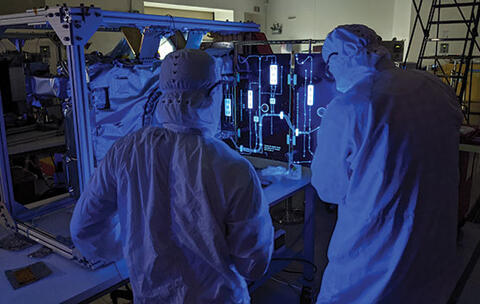
Technicians conducted integration and testing of NASA’s PUNCH satellites during prelaunch operations.
A secondary goal of PUNCH is to provide a new view of space weather such as coronal mass ejections (CMEs) that can drive disturbances in Earth’s space environment. These solar events produce spectacular auroras but can also endanger astronauts, shut down electrical power grids and disrupt satellite-based communication and navigation systems.
Each spacecraft includes a camera, developed by RAL Space, to collect three raw images, through three different polarizing filters, every four minutes. In addition, each spacecraft will produce a clear unpolarized image every eight minutes, for calibration purposes. This new perspective will allow scientists to discern the exact trajectory and speed of coronal mass ejections as they move through the inner solar system, improving on current instruments that only measure the corona itself and cannot measure motion in three dimensions.
PUNCH will track space storms, or coronal mass ejections, in three dimensions as they approach the Earth — critical to understanding space weather. PUNCH technology and techniques are expected to help revolutionize space weather forecasting in the same way that geosynchronous satellites revolutionized weather forecasting on Earth.
PUNCH’s four satellites will provide a new way to visualize a mysterious process happening right here in our own solar system — imaging how the solar corona transitions into the solar wind, which defines our place in the cosmos.
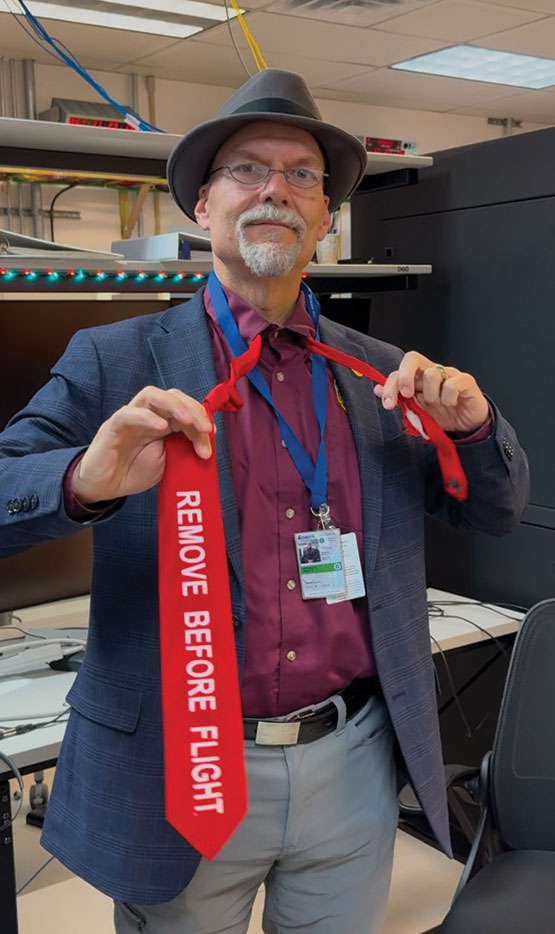
ABOUT THE AUTHOR
Dr. Craig DeForest, principal investigator of NASA’s PUNCH mission, came dressed for success as the team made final preparations to send the four small satellites into orbit, which included pulling the “remove before flight” tags from the payload. As director of SwRI’s Heliophsyics Department in the Solar System Science and Exploration Division in Boulder, Colorado, DeForest specializes in solar wind onset and matter-magnetic-field interactions in the solar atmosphere and solar wind.
Questions about this story or Heliophysics? Contact Dr. Craig DeForest at +1 303 546 6020.

